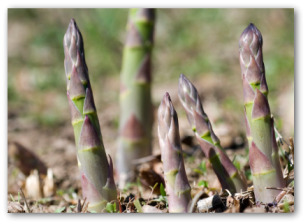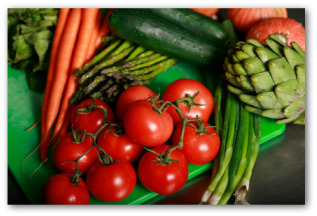Easy Tips for
Harvesting Asparagus

Easy tips for harvesting asparagus in your backyard vegetable garden.
Design Your Own Vegetable Garden Layout Using our Free "Vegetable Garden Planner" Software!
Learn how to build an asparagus bed, plant asparagus crowns, care for, and harvest asparagus plants when gardening.
Succulent asparagus stalks are spear-shaped flower stems or growing shoots of the plants.
The plant shoots are cooked as a vegetable, delicious in stir-fry, or eaten raw.
The plant is particularly susceptible to a fungus called rust, where reddish brown spots develop on the stems and leaves.
For starters, avoid this plant disease by planting rust-resistant varieties.
Our aim here is to provide quick, convenient pointers for successful planting techniques and serve as a reference guide for planting asparagus.
Download Free Garden Planning Worksheets, Garden Diary, Zone Chart, Or Planting Guide
Vegetable Gardening Tips for Planting Asparagus
- Asparagus needs thorough soil preparation before planting because it is a perennial crop that will remain where it is planted indefinitely.
- Once the plant is set, it tolerates only a minimum of disturbance.
- Plant in early spring.
- Purchase one year old dormant roots to start.

Before Planting Asparagus
- Soak the crowns in lukewarm water for an hour before planting.
- To plant crowns, dig a trench a foot wide and 18 inches deep.
- Reserve the topsoil but discard the subsoil.
- Fork lots of organic compost into the bottom of the trench and work it into the bed.
- Add rock phosphate and granite dust to provide plenty of potassium and phosphorous.
Planting Asparagus Crowns
- Make a mound of soil every 2 feet along the trench.
- Set one crown on top of each mound.
- Set crowns so the eyes face upward.
- Spread the roots down and over the sides of the mound.
- Cover crowns with a couple of inches of soil, working it in carefully around the roots with your fingers.
Planting Asparagus Seedlings
- If planting seedlings, draw 2 inches of soil around the base of the plant.
- Water to settle plants or crowns into the soil and eliminate air pockets around the roots.
- As plants grow, periodically add 2 more inches of soil to the trench.
- Continue adding soil until around the middle of the growing season.
- By this time, the trench should be level with the surrounding soil surface.
Asparagus Plant Pests
A serious pest for growing asparagus is tarnished plant bugs.
The pests are ¼ inch long, either green or brown in color, and always have small yellow triangles on each side near their tail ends.
As they feed on stem tips and flowers, the insects inject a toxin that makes black spots form.
The bugs overwinter as adults and are much worse in warmer climates than in colder regions where winter freezes them out.
Harvesting Asparagus
How to Harvest Asparagus the First Year

- One year after planting, you can harvest spears for about a three week period.
- The first year crop will be light.
- When picking asparagus the first year, avoid over-picking as you want the plants to put most of their energy into developing a strong root system.
Picking Asparagus the Second Year and Beyond
- In the following springtime and thereafter, harvesting asparagus can continue over a two month period as long as the spears remain chunky.
- At harvest time, when a height of about 6 inches is reached, snap the spears off at ground level with your fingers.
- Be sure to check your asparagus bed each day, because the shoots grow very quickly during warmer weather.
- In fact, you can almost see them grow! Avoid cutting plants using a knife because that could cause injury to the buds of future shoots.
- Most of a home grown asparagus spear is tender and edible, unlike commercially sold canned spears.
After Harvesting Asparagus

- After harvesting asparagus, it can be stored for several days in an airtight container.
- It can be used fresh, or may be frozen or canned.
- After harvesting asparagus, a suggestion is to include the fresh vegetable in a tasty salad.
The following asparagus recipe serves 6:
- Use about 7 stalks per person, ¾ cup mayonnaise, along with strips of green or red pepper.
- Put stalks together on a lettuce leaf; place garnishes, add 2 tablespoons mayo or favorite salad dressing to each serving.
Home grown asparagus tips frozen separately make delectable garnishes.
Either steam them briefly and serve with butter.
Or thaw them just until they are well separated, dip in beaten egg, then into fine, dry bread crumbs, and deep fry as a side dish for a favorite chicken recipe.

